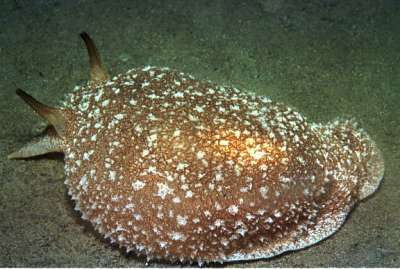
Pleurobranchaea californica
MacFarland, 1966
Order: NOTASPIDEA
Superfamily: PLEUROBRANCHOIDEA
Family: Pleurobranchidae
DISTRIBUTION
West coast of North America (Oregon to California)
PHOTO
La Jolla Shores, San Diego, California. Photo: M.D.Miller
Species of Pleurobranchaea are medium to large pleurobranchs, with a large oral veil and a reduced mantle skirt. There is no shell. The oral veil is broad with sensory papillae along the anterior edge. The dorsum is light brown, mottled irregularly with darker brown and small whitish patches. It is covered with small low rounded tubercles. Scattered amongst these tubercles are larger, usually whitish, tubercles which can extend into a tapering point. Because of the reduced mantle, the large gill is visible on the right side of the body. The foot is broad, thick and muscular, rounded and bilabiate in front. At the posterior end, the foot is bluntly pointed, with a large, median ventral gland. It is usually considered a deep water species, occurring from 3-400m [10 to 1200 feet]. It is a voracious predator feeding upon various invertebrates and fish. Behrens [message 12142] reports it is also a cannibal. Animals can grow to 21cms long. [from Macfarland, 1966]
See Dr Rhanor Gilette's Slug City website at: http://www.life.uiuc.edu/r-gillette/ for photos, dissection guides, movies, and background information on their research into the behaviour of animals with relatively simple brains.
References:
• Battle, K. & Nybakken, J. (1998). The feeding habits of Pleurobranchaea californica MacFarland, 1966 (Gastropoda: Notaspidea) in Monterey Bay, California. The Veliger, 41(3): 213-226
• Behrens, D.W. (1980) Pacific Coast Nudibranchs. A guide to the opisthobranchs of the northeastern Pacific. Sea Challengers. Los Osos, California.
• MacFarland, F.M. (1966) Studies of opisthobranchiate mollusks of the Pacific coast of North America. Memoirs of the California Academy of Sciences, 6: 1-546.
Rudman, W.B., 2004 (February 6) Pleurobranchaea californica MacFarland, 1966. [In] Sea Slug Forum. Australian Museum, Sydney. Available from http://www.seaslugforum.net/find/pleucali
Related messages
Re: Pleurobranchaea californica from Santa Barbara, California
March 31, 2008
From: Mark W. Howe
Concerning message #17665:
The Orange County Floating Lab program, now Ocean Institute in Dana Point, California has been bringing these up from 20-30 fathom range on silty mud bottom for many years. I recall them commonly in the 1970s and now that I am back in the business again, I note they are still there.
A note re morphology, they seem to go from a very flaccid state where the dorsal surface is smooth as in Christina Bonsell's photos, to a contracted rough state exhibiting the papillae noted in Dave Behrens' photo. Another character I have noted is the relatively high profile and vertical sides to the foot at times when extended. Could this be an adaptation for cruising the mud below the surface for feeding and still keep the gills above the surface? Since there are apparently observers using ROVs, I thought I'd see if I could get an answer to this puzzle.
When did the term Tectibranch become so obsolete it disappeared completely?
Locality: Orange County coast, 20-30 fath plus/minus 10 fathoms, California, Pacific, 1970s to present 26 Mar 08, 16 ft otter trawl net. Length: Sea hare [Aplysia] sizes
markhowe@cox.net
Howe, M.W., 2008 (Mar 31) Re: Pleurobranchaea californica from Santa Barbara, California. [Message in] Sea Slug Forum. Australian Museum, Sydney. Available from http://www.seaslugforum.net/find/21476Hi Mark,
Interesting posting. Years ago I collected quite of few monster size specimens in the same area, via Rim Faye's - Pacific Biomarine. I was looking at the feeding habits of this giant vacuum cleaner. This is when we first learned that the species was cannibalistic, slurping up just about anything, including smaller individuals in its path.
Can't really comment on your question about the morphology of the photo, as I have never seen living specimens in their actual habitat. Your hypothesis seems right on certianly. Slow fish beware.
Concerning the old name Tectibranch, yes it bit the dust some time ago. Depending on who you follow, the group is now referred to as Notaspidea or the most recent, and correct - Pleurobranchomorpha.
Thanks for sharing this,
Dave Behrens
Pleurobranchaea californica from Santa Barbara, California
September 1, 2006
From: Christina Bonsell
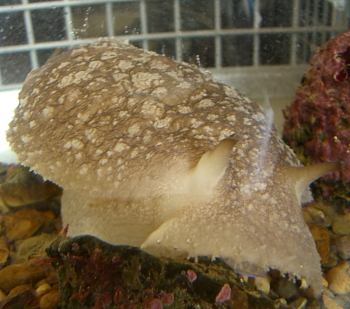
Hi,
I am a high school student and volunteer at an aquarium in Santa Barbara, California. We recently got a new nudibranch that no one can ID. It was bugging me that I could only tell visitors that it was "some kind of nudibranch" and it would be great if I knew more about it. Sorry about the poor picture quality. It is kept in a tank and it was rather reflective.
Locality: Santa Barbara, California, Santa Barbara Channel. Length: 23 cm approx.
Thanks a bunch,
Christina B.
lettem_eat_Cake@yahoo.com
Bonsell, C., 2006 (Sep 1) Pleurobranchaea californica from Santa Barbara, California. [Message in] Sea Slug Forum. Australian Museum, Sydney. Available from http://www.seaslugforum.net/find/17665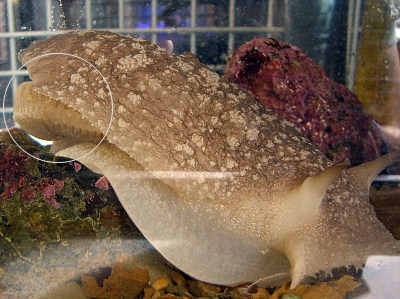
Dear Christina,
This is a sea slug, but not a nudibranch. It is Pleurobranchaea californica, which belongs to a group called the pleurobranchs or side-gilled slugs, because they usually have one large gill on the right side of their body between the mantle and the foot. In your lower photo I have put a ring around part of the gill which is visible. Have a look at the species Fact Sheet for more information
Best wishes,
Bill Rudman
Pleurobranchaea californica from deep water
June 1, 2006
From: John Butler
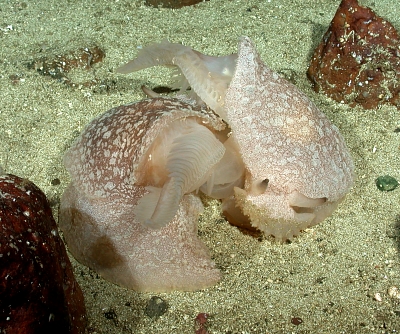
Bill,
Dave Behrens asked me to share this photo of mating Pleurobranchaea californica. The photo was taken off San Diego, California in 265 m depth from a ROV with a Scorpio Digital (Nikon CoolPix 955) camera.
Regards.
John Butler
John.Butler@noaa.gov
Butler, J., 2006 (Jun 1) Pleurobranchaea californica from deep water. [Message in] Sea Slug Forum. Australian Museum, Sydney. Available from http://www.seaslugforum.net/find/16714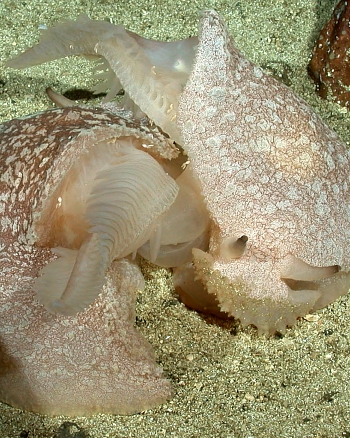
Thanks John,
Dave Behrens in Eastern Pacific Nudibranchs notes that species has been reported from 1200 ft so your animals are certainly at the deeper part of its known range. It is interesting how in each animal the gill is held aside to facilitate mating. The reproductive organs, and openings, are on the right side just beneath the anterior part of the gill.
Best wishes,
Bill Rudman
Mating Pleurobranchaea californica
March 15, 2006
From: Kevin Lee
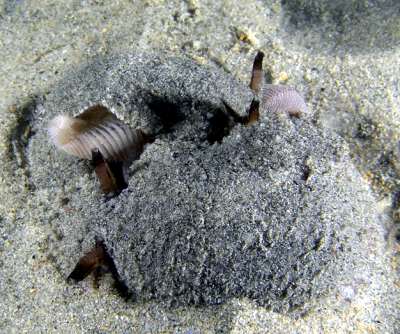
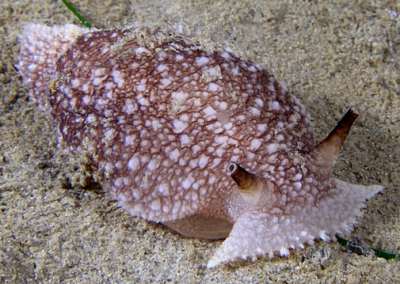
Thought I'd contribute a pair of mating Pleurobranchaea californica. What I thought were some worms, next to each, are, perhaps the gills?
Locality: Canyon Main Wall, La Jolla Shores, approx. 65 feet, California, Eastern Pacific, 06 November 2005, Sandy bottom. Length: approx. 1.5 inches. Photographer: Kevin Lee.
K:-)
diverkevin@gmail.com
Lee, K., 2006 (Mar 15) Mating Pleurobranchaea californica. [Message in] Sea Slug Forum. Australian Museum, Sydney. Available from http://www.seaslugforum.net/find/16103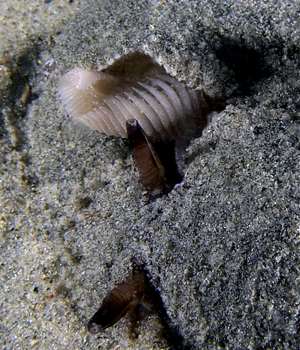
Thanks Kevin,
Yes the white feathery structires are the gills
Best wishes,
Bill Rudman
Gill structure of Pleurobranchaea californica
October 11, 2005
From: Michael D. Miller
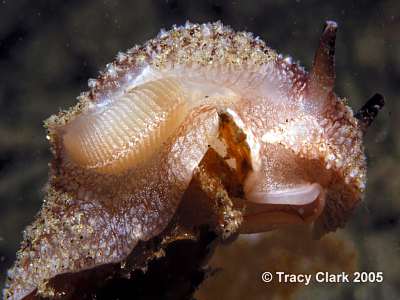
Dear Bill
I am forwarding an extraordinary photograph taken by local U/W
photographer Tracy Clark (with his permission) of the gill structure of Pleurobranchaea californica.
Photo was taken at La Jolla Shores, San Diego, California. P. californica
has been quite abundant here the past month or so.
Michael D. Miller
mdmiller@cts.com
Miller, M.D., 2005 (Oct 11) Gill structure of Pleurobranchaea californica. [Message in] Sea Slug Forum. Australian Museum, Sydney. Available from http://www.seaslugforum.net/find/14979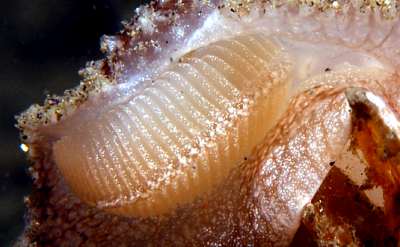
Thanks Mike - and Tracy,
The photo defintiely shows why these animals are called 'side-gilled slugs'.
Best wishes,
Bill Rudman
Pleurobranchaea californica from San Diego
February 6, 2004
From: Dave Behrens

Bill:
I see you need a photo of Pleurobranchaea californica. Here is a dandy taken by Mike Miller. It was shot at La Jolla Shores, San Diego, California. This is unusual because as you know this species is a deeper water creature living primarily below depths of 30-1200 feet. It ranges is from Port Orford, Oregon to San Diego, California on the Pacific Coast.
I have examined the gut contents of specimens up to nearly 10 inches in length, to learn that they feed not only on all
variety of sand and mud bottom nvertebrates, but unsuspecting fish, such as small sole and sanddabs. The most interesting aspect of its feeding behavior is that it cannibalizes its own species, a 10 inch individual examined contained 7 one inch younger brethren.
Dave Behrens
Sea Challengers
dave@seachallengers.com
Behrens, D., 2004 (Feb 6) Pleurobranchaea californica from San Diego. [Message in] Sea Slug Forum. Australian Museum, Sydney. Available from http://www.seaslugforum.net/find/12142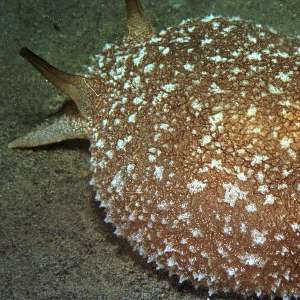
Thanks Dave, and Mike,
I had not realised that this species has quite noticeable pointed papillae on the dorsum, which are very visible in Mike's photo. Compared with other west coast opisthobranchs, the known geographic distribution seems rather restricted. Compared with other west coast organisms is this distribution reasonable, or is it likely to be me widely distributed when more collecting is done in the depths it is usually found?
Best wishes
Bill Rudman
